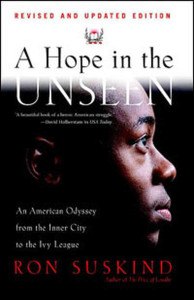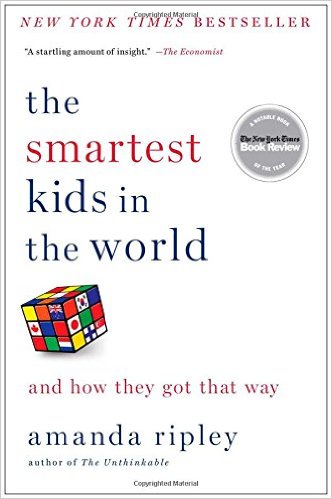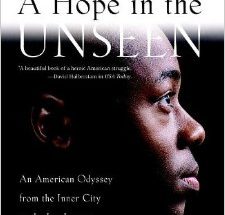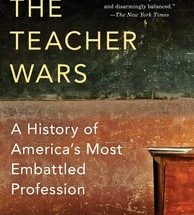The great American promise is that if you work hard—no matter where you come from—you can be anything you want to be. Ron Suskind set out only to challenge that notion when he began reporting A Hope in the Unseen, published in 1995. And the then Wall Street Journal reporter took it several steps further–to understand more deeply what that means for “the other America.”
The book is an extension of Suskind’s Pulitzer Prize-winning series on honor students at Ballou High School in Washington, DC, one of the city’s worst high schools located in its most dangerous neighborhood. During that reporting he met Cedric Jennings, the book’s central character.
From the first page to the last, Suskind’s reporting is precise, his writing is clear and the narrative that he weaves together is seamless. It is Suskind’s writing that brings nuance and substance to the experiences of poor African Americans who are trying to climb out of despair and hardship, creating three-dimensional characters. Much of what is written about “the other America” — mostly people of color who face systemic challenges in social mobility–doesn’t go any deeper than playing with their vulnerabilities. In this book, Suskind immerses himself with these characters to not only understand their lives, but to effectively become a part of them, capturing the struggles, thoughts and the everyday lived experiences. In the course of reporting the book, he stripped away stereotypes and put flesh on the anecdotes and statistics.
Suskind calls it, “An American odyssey from the inner city to the Ivy League.” He follows Cedric, capturing his angst as a lonesome high school sophomore, to his elation when he is accepted into a prestigious MIT summer prep program for minority students, to his junior year at Brown University, and everything else in between.
At the beginning of the book we meet Cedric as a rising sophomore at Ballou. He is a hard-working, determined, thoughtful, shrewd—and oftentimes stubborn—young man. He is the star student to the teachers and an outcast to his peers. He stays in the shadows at Ballou, missing award ceremonies that honor the few good students at Ballou like him, to avoid his bullies. He would rather sit in his favorite teachers’ classrooms and study for the SAT than go to lunch.
Aside from school, the “everything else in between” centers on his home life and the constant hurdles he faces. Cedric has typical teenage worries, but is forced to be a man in the way his unprivileged life requires. He has to dodge drug dealers leaving school, cook dinner when he gets home and then spend all night studying, getting very little sleep.
Suskind doesn’t just focus on Cedric, he also tells the story of his mother, a woman who pays enormous costs to protect her son. Her name is Barbara. Through Suskind’s precision in reporting and storytelling the reader understands that she is a humble, church-going woman of quiet humility with a backbone of steel. She tries desperately to insulate her son from the constant lure of drugs, crime, gangs and failure that plague their impoverished DC neighborhood. Sometimes, to no avail. Suskind is with her when she makes sure she and Cedric (She calls him by his middle name: Lavar) are in church every Sunday. He follow her when she comes home from work dog-tired, and even when she puts her last $20 in the church collection plate hoping and praying for a better life for her and Lavar.
Suskind brings universal elements to Cedric’s story, as he tries to understand why he is bullied and ridiculed for being smart, why he has to do some of things he has to do, and he is constantly embattled by figuring out how to make his circumstances better. The book explores three main themes: identity, acceptance and education. Cedric is a complex character with internal struggles that Suskind doesn’t exploit but humanizes. One problem in his life is his father, who is also named Cedric, which is why his mother calls him Lavar. The elder Cedric is a classic recidivist. He is a longtime drug user and dealer, even though he has a college degree. His crimes have landed long him in and out of jail, probation and work release programs. Lavar wants his father’s love, but realizes it’s a futile effort.
Through his selection of scenes, quotes and dialogue, Suskind successfully achieves his goal of informing the reader that there are larger forces at work that impede on the success of this family who realizes that great American Dream has not held up its end of the bargain.
We see Cedric constantly question his hard work and whether it’s worth it. He thinks about what the kids at the “good schools” are doing and whether he will make it, especially after being at MIT then Brown, from which he ultimately, with much pain, graduated.





